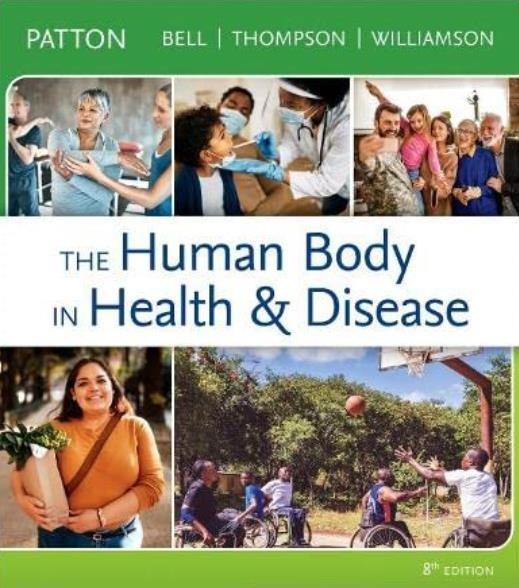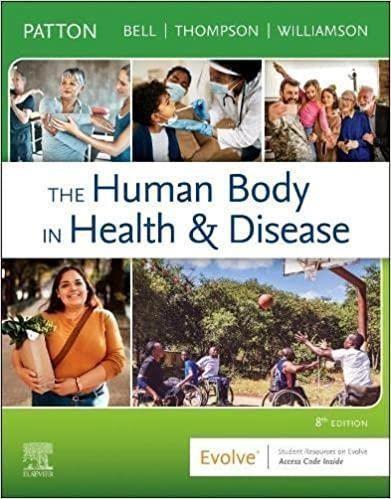
Chapter 01: Introduction to the Body
Patton: The Human Body in Health & Disease, 8th Edition

MULTIPLECHOICE
1. Which word is derived fromthe Greek word meaning “cutting up”?
a. Dissection
b. Physiology
c. Pathology
d. Anatomy
ANS: D PTS: 1 DIF: Memorization
REF: P.3 TOP: Introduction
2. Which word is defined as the studyofthe function of living organisms and their parts?
a. Dissection
b. Physiology
c. Pathology
d. Anatomy
ANS: B PTS: 1 DIF: Memorization
REF: p. 3 TOP: Introduction
3. Which word is defined as the scientific studyof disease?
a. Dissection
b. Physiology
c. Pathology
d. Anatomy
ANS: C PTS: 1 DIF: Memorization
REF: P. 3 TOP: Introduction
4. Cells
a. are more complex than tissues.
b. arethe first level oforganization in the body.
c. arethe smallest living units ofstructure and function in the body.
d. both B and C.
ANS: C PTS: 1 DIF: Application REF: p. 6
TOP: Structural levels of organization
5. Agroup of cells that act together to perform a function is called a(n)
a. molecule.
b. organ.
c. tissue.
d. organism.
https://www.stuvia.com/en-us/doc/2452947/test-bank-for-thehuman-body-in-health-and-disease-8th-edition-all-chapters
ANS: C PTS: 1 DIF: Memorization
REF: p. 6 TOP: Structural levels oforganization
6. The heart is an example of a(n)
a. organ.
b. tissue.
c. organism.
d. system.
ANS: A PTS: 1 DIF: Application REF: p. 6
TOP: Structural levels of organization
7. The levels oforganization from most simple to most complex are
a. cell chemical organ tissue system.
b. tissue cell chemical organ system.
c. chemical tissue cell organ system.
d. chemical cell tissue organ system.
ANS: D PTS: 1 DIF: Memorization
REF: p. 5 TOP: Structural levels oforganization
8. When using directional terms to describe the body, it is assumed thatthe bodyis in what position?
a. Supine
b. Anatomical
c. Lateral
d. Prone
ANS: B PTS: 1 DIF: Memorization
REF: p. 7 TOP: Anatomical position
9. The supine position
a. describes the body lying face up.
b. is also called anatomical position.
c. describes the body lying face down.
d. both A and B.
ANS: A PTS: 1 DIF: Memorization
REF: p. 7 TOP: Anatomical position
10. The prone position
a. describes the body lying face up.
b. is also called the anatomical position.
c. describes the body lying face down.
Download All Chapters At :
d. both B and C.
https://www.stuvia.com/en-us/doc/2452947/test-bank-for-the-humanbody-in-health-and-disease-8th-edition-all-chapters
ANS: C PTS: 1 DIF: Memorization
REF: p. 7 TOP: Anatomical position
11. Because humans walk upright, the term dorsal can be used in place of the term
a. inferior.
b. posterior.
c. anterior.
d. distal.
ANS: B PTS: 1 DIF: Memorization
REF: p. 7 TOP: Anatomical direction
12. The opposite term for posterior in humans is
a. superior.
b. anterior.
c. ventral.
d. both B and C.
ANS: D PTS: 1 DIF: Application REF: p. 7
TOP: Anatomical direction
13. The opposite term for superficial is
a. deep.
b. inferior.
c. posterior.
d. medial.
ANS: A PTS: 1 DIF: Memorization
REF: p. 7 TOP: Anatomical direction
14. The bodysection that divides the right ear fromthe left ear is a section.
a. frontal
b. sagittal
c. coronal
d. transverse
ANS: B PTS: 1 DIF: Application REF: p. 9
TOP: Planes or bodysections
15. The bodysection that divides the nose from the back of the head is a section.
a. frontal
b. sagittal
c. midsagittal
d. transverse
ANS: A PTS: 1 DIF: Application REF: p. 9
TOP: Planes or bodysections
16. Asection that divides the bodyinto mirror images is a section.
a. frontal
b. coronal
Download All Chapters At :
c. midsagittal
d. transverse
https://www.stuvia.com/en-us/doc/2452947/test-bank-for-thehuman-body-in-health-and-disease-8th-edition-all-chapters
ANS: C PTS: 1 DIF: Application REF: p. 9
TOP: Planes or bodysections
17. The two major bodycavities are called
a. thoracic and abdominal.
b. thoracic and pelvic.
